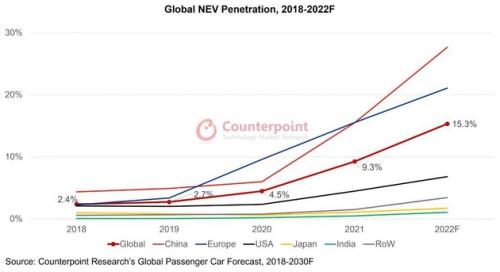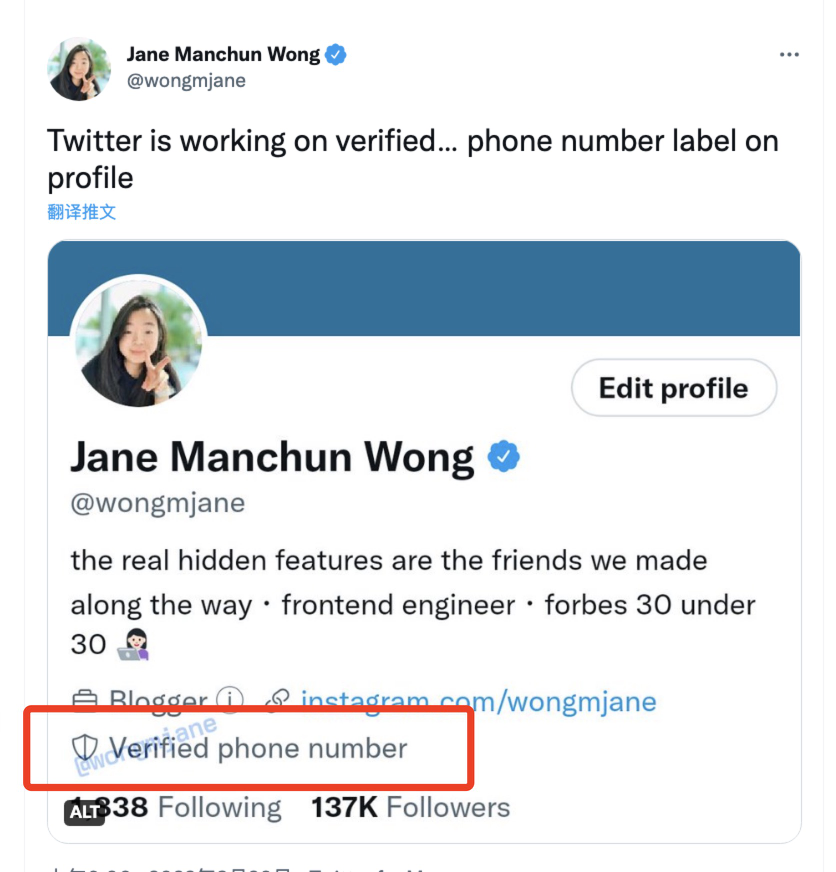your current location is:Home > TechnologyHomeTechnology
The iPhone 14 Pro is hard to stop Apple from falling
The new iPhone has made another contribution, reversing Apple's declining net profit.
In the early morning of October 28, Beijing time, Apple released its financial report for the fourth quarter of fiscal 2022 (ie, the third quarter of 2022). According to the quarterly financial report, Apple’s total revenue in the third quarter was US$90.15 billion, an increase of 8% year-on-year; net profit was US$20.72 billion, a slight increase of 1% year-on-year.
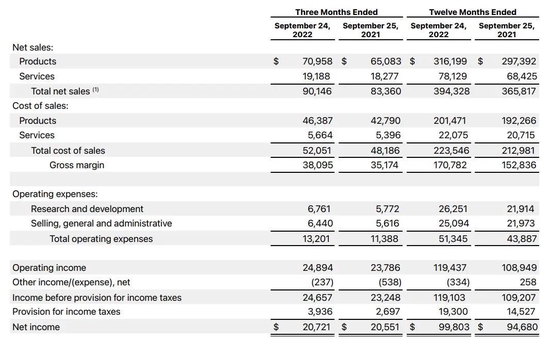
Although the increase in net profit was not large, it successfully helped Apple out of the crisis of another decline. In the second quarter, Apple's net profit rarely staged the first year-on-year decline, with a decline of 10.6%.
Judging from the financial report, the iPhone product has contributed. In the third quarter, revenue from iPhone was $42.63 billion, an increase of 9.6% compared with $38.87 billion in the same period last year. This increase not only created a new high for Apple's iPhone growth in the past few quarters, but also made the iPhone three years later. Once again surpassed the growth rate of service revenue and regained the first place.
In contrast, revenue from services in the third quarter was US$19.19 billion, an increase of only 5% compared to US$18.28 billion in the same period last year, which also set Apple's first quarter of this year. Service revenue growth fell below double digits. record.
In other products, revenue from Mac was $11.508 billion, up from $9.178 billion in the same period last year; revenue from iPad was $7.174 billion, up from $8.252 billion in the same period last year; Accessories revenue was $9.650 billion, up from $8.785 billion a year earlier.
The gains from the iPhone are also reflected in regional revenue. With the release of the new iPhone 14 series, in the third quarter, Apple's revenue in Greater China reached US$15.47 billion, which also achieved a reversal from falling to rising, an increase of 6% compared with US$14.56 billion in the same period last year. In the second quarter, revenue in Greater China fell by 1% year-on-year.
In the other four major regions in the world that contribute revenue to Apple, revenue from the Americas in the third quarter was US$39.81 billion, an increase of 8% compared with US$36.82 billion in the same period last year; revenue from Europe was US$22.8 billion, compared with last year. In the same period, the revenue of US$20.79 billion increased by 9.6%; the revenue from Japan was US$5.7 billion, which was lower than the US$5.991 billion in the same period last year; the revenue from the rest of the Asia-Pacific region was US$6.37 billion, higher than the US$5.19 billion in the same period last year.
Although the growth rate of iPhone revenue has reached a new high, due to the cold market of the iPhone 14 and iPhone 14 Plus versions, Apple's iPhone and service revenue in the quarterly financial report failed to meet Wall Street expectations.
During the earnings call, Apple CEO Cook responded that despite signs that other smartphone companies are struggling with the recent drop in demand, "Apple's performance in mobile phone sales remains strong." Continuing the second quarter attitude, Cook once again Reiterated the company's plan to slow the pace of hiring.
A
Apple is having its second-best quarter of the year. With the launch of new iPhones in September, the third and fourth quarters of the past year are two key cycles for Apple to sprint revenue.
Market statistics also confirm this. Canalys recently released global third quarter and China third quarter smartphone market reports both show that under the weakening demand for consumer electronics, Apple has not only become the only manufacturer in the world to grow against the trend (the share increased from 15% in the same period last year to 18%), And it is also the only mobile phone brand in the Chinese market (shipment volume up 36% year-on-year).
As for the reason for Apple's significant growth, Canalys analyst Amber Liu directly stated that "the strong demand for the iPhone 14 Pro series has promoted Apple's overall performance."
Faced with the year-on-year decline in revenue from iPads and Macs in the second quarter, Cook once comforted investors, saying that the main reasons for this situation were supply constraints and the strengthening of the US dollar, and pinned his hopes on sales after September. During the peak season, the forecast says "revenue growth will accelerate in the September quarter despite some weakness."
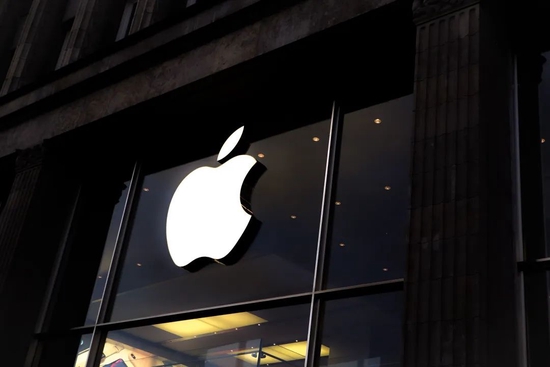
In order to complete the accelerated revenue growth in Cook's mouth, the iPhone 14 series conference was held one week earlier than in previous years. At that time, Guo Mingchi, a well-known Apple analyst at Tianfeng International Securities, once analyzed that this was largely to boost Apple in the third quarter. of sales.
When it comes to controlling the cycle of Apple's revenue growth and decline, no one understands Cook. However, while reversing the decline of the previous quarter, new dangers for Apple are emerging.
JPMorgan Chase issued a warning in October, saying, "The iPhone 14 is still early in the product cycle, but we expect a weak consumer environment to affect the earnings trajectory. Earnings in the latter quarters of fiscal 2023 may be lower than the market consensus." Crucial to Apple In the important fourth-quarter holiday season, Wall Street analysts believe that iPhone growth will slow sharply to 2%, and it is difficult to maintain the current high growth rate close to 10%.
Canalys analyst Zhu Jiatao also pointed out in the report that iPhone demand in the Chinese market will also weaken significantly in the next two quarters. Affected by rising U.S. interest rates that dampen consumer spending, TrendForce even adjusted its forecast for fourth-quarter iPhone production, down 14% to 52 million units from the original 56 million units.
B
In response to changes in the external environment, Cook is making Apple "serving" soft.
At the same time that Apple replaced the entire series of iPads from Lightning to USB-C, the European Union officially approved a new unified charging interface regulation, requiring that from the fall of 2024, whether smartphones, headphones, or digital cameras, tablet computers , manufacturers of all products will use the same universal charging port - USB-C, and by the end of 2026, laptops will also be replaced by USB-C ports.
Recently, Greg Joswick, Apple’s senior vice president of global marketing, responded to the matter, saying that Apple will have to comply with EU law and use the unified charging standard USB-C.
According to the Forbes website in the United States, some supply chain sources broke the news that the iPhone 15 series launched next year will be compatible with the USB-C interface for the first time, but only for the Pro model. The iPhone 16, which will be launched in 2024, will be fully equipped. But USB-C is only Apple's short-term transition plan to the European Union. In the long-term plan without ports, MagSafe wireless charging is the ultimate choice for the iPhone.

Apple has been working on a portless design in the past. In the US version of the iPhone 14 series released this year, the physical SIM card slot was completely eliminated. Earlier, Apple also cut off the 3.5mm headphone jack.
Faced with the main business of the iPhone, where innovation has basically stagnated and the room for price increases has peaked, Cook's other major move to "serve" softness is to develop software service revenue items and subscription prices.
After Bloomberg broke the news in August that Apple is expected to change the advertising implementation rules and plan to expand advertising to more areas such as iPhone and iPad, in October, Apple officially sent a notification email to iOS third-party developers. The "Today" tab of the App Store, as well as the "You May Also Like" section at the bottom of each software page window, will display software-related ads. This is the first time Apple has allowed third-party developers to display software ads in the aforementioned tags.
On the second day after announcing the new advertising space, Apple raised the prices of Apple Music and Apple TV+ services for the first time on the grounds of rising copyright fees and increasing the richness of platform content: the price of Apple Music services was raised from $9.99 to $10.99 per month; Apple TV+ is up from $4.99 to $6.99.
Internally, the decline in Apple's software services revenue growth is also forcing Cook to make some changes. In the third quarter financial report, the year-on-year growth rate of Apple's service revenue fell from double digits in the past few quarters to single digits, and the revenue growth for the entire 2022 fiscal year was only 14%, showing a downward trend year by year.
C
On the way for Cook to develop more service revenue, there are also many challenges.
After the announcement of the new ad placement notice, U.S. legal expert Mueller once commented, "This is actually an increase in the 'tax rate' levied on software developers by the Apple App Store. In order to avoid other competing software from grabbing their own pages To take potential users, third-party developers will be forced to buy ad space on their own pages.”
According to Apple's updated new payment rules, users and advertisers need to use Apple's "in-app purchase" channel when purchasing "promoted" posts on major social software, which means they need to pay a 30% commission to Apple.
Such new regulations quickly aroused dissatisfaction among major advertisers. For example, Meta immediately commented and accused, "Apple has said before that they do not share in the developer's advertising revenue, and obviously they have changed their minds now", by modifying the terms of the App Store The way Apple is taking a share of its social media advertising revenue is what Meta sees as Apple "undercutting other companies in the digital economy."
In 2019, Spotify, which sued Apple's monopoly because of the 30% "Apple tax", stood up again. Spotify CEO Eke said that Apple's rules made the process of buying audiobooks on Spotify "too complicated and confusing" and believed that “Without government intervention — in Europe, the U.S. or any other market in the world — Apple has repeatedly shown that it will not self-regulate and has no real incentive to change.”
Apple’s rejection of the Spotify audiobook app three times in a month attracted the attention of Tesla CEO Musk, who replied to Eke on Twitter that it was indeed “worrying” and once again criticized the Apple tax To do this, reply below the post "Take a 30% cut for social media advertising" saying "30% is really too high".
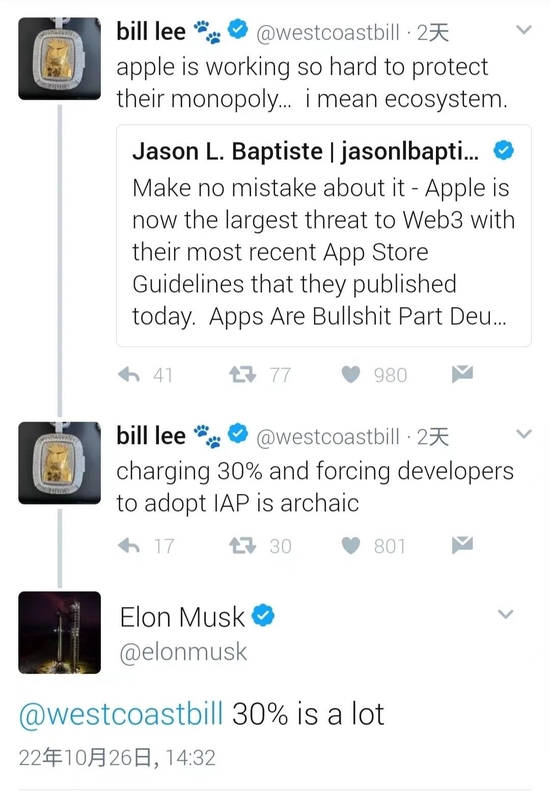
As early as last July, Musk mocked Apple's use of power to build a "walled garden".
Compared with the dissatisfaction from companies and entrepreneurs, Apple's bigger crisis is the stricter supervision of policies in various countries.
In early July, the EU formally passed the Digital Markets Act (DMA) and the Digital Services Act (DSA) to try to solve the data monopoly problem of large technology companies, requiring Apple, Google and other large technology companies to "allow users to Install apps from third-party app stores and sideload them directly from the Internet" "Allow developers to provide third-party payment systems in apps", etc.
The DMA will take effect next year, and tech giants who violate the regulations will face a fine of up to 10% of the total global turnover; if repeated violations, the EU will also add a regular fine of 5% of the total global turnover in addition to the 10% fine.
This will undoubtedly be a bigger trouble than replacing the USB-C interface on the hardware for the service business that Cook has built and grown.
For Cook, it may be time to consider landing a third growth curve for Apple as soon as possible in addition to the two major revenue growth channels of iPhone and software services.
Previous:Elon Musk: I only do 3 things in Twitter: fairness, humanity and advertising
Next:Silicon Valley giants are more miserable, and Apple is alone?
related articles
Article Comments (0)
- This article has not received comments yet, hurry up and grab the first frame~








